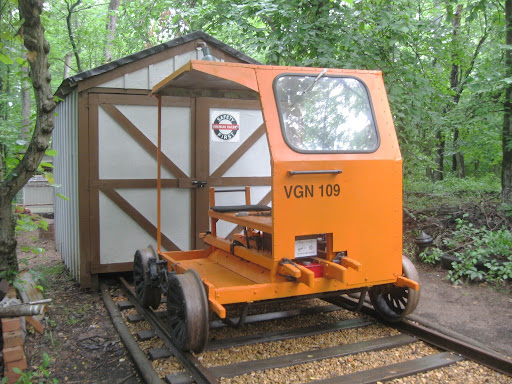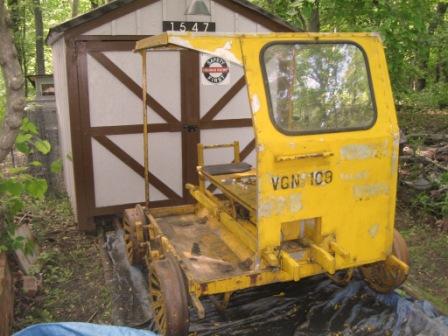In researching motor cars of the Virginian Railway I found that I was plowing new ground all the way. Nothing had been published nor had any information been assembled. My research and conclusions were based on primary sources and I feel the motor car 109 is as close to authentic as possible. I studied company records, interviewed and questioned former Virginian employees and carefully noted what I found on my motor car as I took it back to bare metal and wood.
I would like to express my appreciation to friends who have helped my research by sharing information and guiding me to good sources and by advising me for the actual work. Thank you Harry Bundy, Greg Elam, Dave Kotsonis, George Lewis, Jon Lewis, Charlie Long, Harry McLaughlin, Edwin Massie, Chip Oaks, Rick Rader, David Wimmer and the Archives of the N&W Historical Society. The men named represent the spectrum of individual, primary sources I have found; railroad historians, VGN signalmen, VGN engineers and trainmen and a worker from the Princeton coach shop where motor cars were repaired.

In July 2009 I agreed to a trade that brought this grand old lady, built 1921, to my collection of railroad relics. In preparation, I built a 2/3 scale replica VGN motor car shed and painted it in the color scheme adopted by the railroad after World War II, gray with dark brown trim. In late March 2011 the actual restoration began. Read on and see how the restoration progressed.Start at the bottom entry and read upward. That's a blog. The picture above shows the 109 completed July 6,2011
VGN RY Motor Car 109

Sitting in front of replica 2/3 scale VGN motor car shed in 2009
Wednesday, June 29, 2011
Monday, June 27, 2011
Detailing the 109 * Starting June 27, 2011


This morning, Monday, June 27th, I started on the ninety year old gas tank. The strainer in the filler neck is still in good condition. The fuel, by the way, could be either a mixture of kerosene and oil or gasoline and oil, according to the Operator's Manual. On one side I found where a hole had been patched. It wasn't along the bottom or in a corner but half way up one side. When I started on the opposite side, there was a patched hole there too! I could understand holes being on the bottom but why half way up and the two holes matched in location. Then it hit me! They were bullet holes! Like other railroads there were labor strikes on the Virginian and Greg Elam of Victoria relates how some of the VGN men told him of having their trains shot at during strikes. A shot through the gas tank would disable this motor car for a while. The small white arrow indicates one of the two patched holes. The other hole is on the other side.
Another picture shows what the motor car operator would see looking down at his controls. The windshield is ahead. The spark advance and drip feed are painted dark green, the color found under layers of other colors of paints. A little of the bright red gas tank is seen. The brass plate in front of the controls has the characters, "VGN 109" stamped in and also an N&W number 64033 which is upside down. It some circles the upside down placement is the ultimate insult. I didn't make this plate, it was on the car for a long time when I received it. On the right is the electrical control. The white slide was actually the key and it could be positioned so that both cylinders or just one cylinder could run.
Thursday, June 23, 2011
Painting the 109 * Starting June 23 2011


After weeks of cleaning and sandblasting, the car is being primed for the orange color worn when in service on the Virginian. The primer is industrial grade, oil based. June 23, 2011
The first of many coats of orange is drying. I am excited to work more but I have to let it sit and dry hard before putting on another coat. June 25, 2011
Monday, June 20, 2011
109's Clean Front * June 20 2011

After gentle media blasting, the front and top of 109 are nearly ready for primer paint. The last few areas of old paint will be removed with an electric sander. In this phase I found the original red oxide primer and orange paint which had been brushed on. Two coats of yellow were on top of the orange, one applied by VGN and one applied by N&W workers some time after the 1959 VGN/N&W merger.
June 20, 2011.
Wednesday, June 15, 2011
Original Colors * June 15 2011




When Sheffield Motor Car Company shipped its motor cars, they left the plant painted dark green. I am finding traces of that dark green paint as seen in the picture of the controls, A part number was revealed in the cleaning. Also the car's Virginian era color of orange is showing up on the car, both on wooden pieces and on the aluminum parts. The original VGN color of orange is verified by a former Virginian signalman who told me that the VGN used orange paint on the motor cars which was the same orange as was used on the stations. He added that this practice was followed until they were painted yellow, starting about 1958. Black was used on some metal parts, such as the guides for the lifting handles. June 15, 2011
A picture shows a sheet of paint that came off the front. The red is the red oxide primer used when the front and top were added in 1953. Notice how the orange brush stokes show up! The motor car was last painted by N&W in Roanoke in April 1964. That date is on the right side of the battery box.
Tuesday, June 7, 2011
Nooks and Crannies * June 7 2011
Getting the several layers of paint off some metal pieces is very hard, even with a media blaster using a hard blasting material. I tried used a chemical paint remover and when the paint started to blister, I hit it with the sandblaster. That has worked some of the time. A few days ago I had another idea; heat the stubborn areas on the steel wheels with a blow torch and then hit them with the sandblaster. That is working very well. But whichever method I use, progress is slow. The wheels are particularily difficult because they must have come from other cars that had been damaged and retired. Three wheels seem to have four layers of paint while one wheel has five layers! Ghee, the car should be lighter not having all those layers of paint! ;O)
Subscribe to:
Posts (Atom)